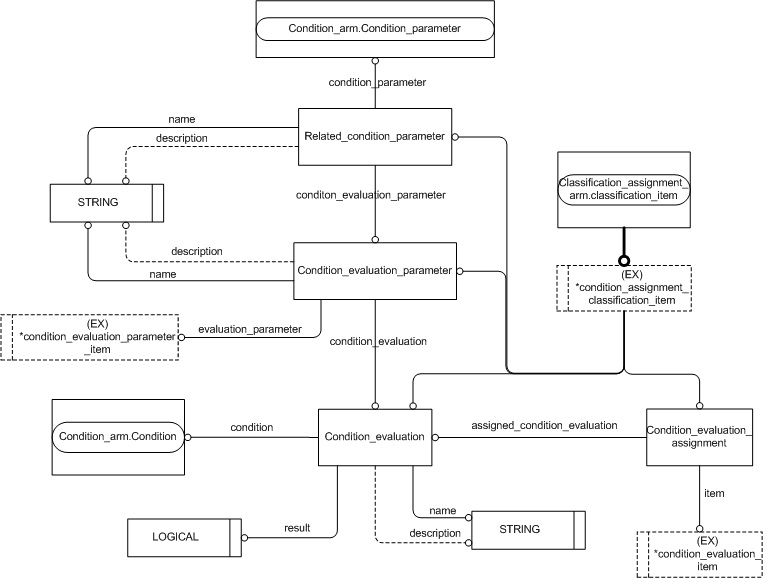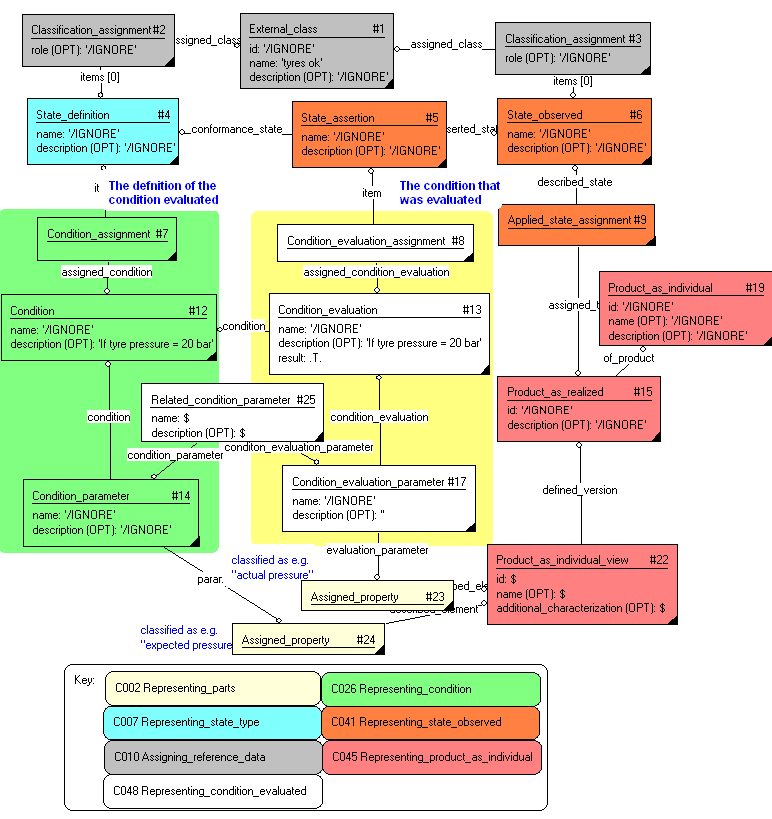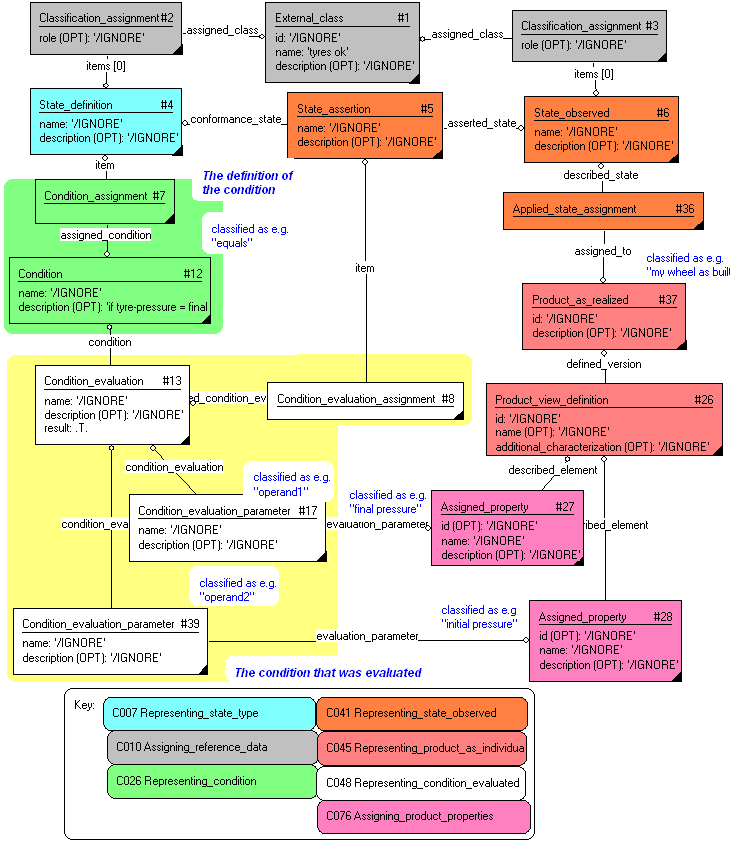
| Capability (C048):— representing_condition_evaluated | Date: 2012/05/23 17:48:01 Revision: 1.31 |
This section provides a business level overview of this capability.
This capability describes how to represent a record of the evaluation of a conditional clause.
A conditional clause is an "if then else" statements consisting of operators and operands (parameters).
EXAMPLE "If the measured value of oil pressure from gauge 3 on a car is less than 2 bar then check the oil level" is an example of a conditional clause.
Conditional clauses are typically used to represent when task should be done.
This section provides an overview of the information model that supports this capability.
The information required to represent the record of an evaluated condition is summarized in the EXPRESS-G diagram in Figure 1 below and described in the following sections.

The record of an evaluated condition is represented by Condition_evaluation. This is related back to the Condition that has been evaluated through the Condition_evaluation.condition attribute.
The consequences of the evaluation of the condition, that is the action that resulted, is represented by a Condition_evaluation_assignment relating the Condition_evaluation to the consequence.
A description of a Condition is provided in the capability C026: representing_condition.
Representing a Text Based Condition
The simplest representation of a condition is a text based description of an IF statement. The conditional statement will be of the form:
If text_based_condition Then consequence statement.
The text_based_condition could be any text describing the actual condition that was evaluated.
A text based condition is represented as follows:
The consequence statement is represented by:
The example in Figure 2 shows the evaluation of the condition:
If the tyre pressure is = 20 bars then state of the wheel is "Tyres OK".
The definition of the condition "If the tyre pressure is = 20 bars then state of the wheel is Tyres OK" is provided by Condition (#12). The "inputs" to the condition, i.e. the predicted tyre pressure, is specified by the Assigned_property (#24) which is related to Condition (#12) by Condition_parameter (#14).
NOTE Details on how to present properties are provided in the capability C076: assigning_product_properties.
The record of the evaluated condition is provided by Condition_evaluation (#13) which is linked back to the definition (Condition (#12)) via the condition attribute.
The record of the actual parameters that were used to evaluate the condition are provided by Assigned_property (#23) which represents the actual pressure measured which is related to Condition_evaluation (#13) by Condition_evaluation_parameter (#17).

Representing a Comparison Expression
The condition in the conditional clause can represent a comparison between two condition parameters. The conditional statement will be of the form:
If comparison_expression Then consequence statement.
The comparison_expression part of the statement is often defined as:
operand1 comparison_operator operand2.
The comparison operators are: 'Equals', 'Greater than', 'Greater than or equal to', 'Less than', 'Less than or equal to' and 'Not equal'.
A comparison_expression is represented by:
The consequence statement is represented by:
The example in Figure 3 shows the evaluation of the condition:
If the initial pressure equals the final pressure bars then state of the wheel is "Tyres OK".

Representing a Logical expression
The condition in the conditional clause can represent a logical expression between condition parameters. The conditional statement will be of the form:
If logical_expression Then consequence statement.
The logical_expression part of the statement is often defined as:
operand1 comparison_operator operand2.
The logical operators are: 'AND', 'OR', 'XOR' and 'NOT'.
A logical_expression is represented by combining conditions through
The consequence statement is represented by:
Issue: TJT-1 by Tim Turner (06-04-15) [major_technical, open] - {Type = contents}
The state of this capability is in question. Most of the reference data previously defined for use with the logical expressions defined within has been removed, which makes the the use of both the logical expressions and the reference data questionable. Similarly, the issue raised in RBN-1 implies that the logic used is also suspect in this capability and should be regarded as a major technical issue against the capability - with greater detail about the inadequacies.
Issue: TJT-2 by Tim Turner (06-04-15) [editorial, open] - {Type = contents}
This capability needs a template to allow the assignment of a condition_evaluation to an item, to relate it to a condition and to allow a related instance of condition_evaluation_parameter to be assigned a parameter item.
Issue: TJT-3 by Tim Turner (06-04-15) [minor_technical, open] - {Type = contents}
This capability needs reference data for the condition_evaluation, the condition_evaluation_assignment, and the condition_evaluation_parameter.
Issue: TJT-4 by Tim Turner (06-04-15) [minor_technical, open] - {Type = contents}
This capability needs to reference the use of a document to capture condition_evaluation statements, and associated reference data.
Issue: RBN-1 by Rob Bodington (03-11-04) [minor_technical, open] - {Type = contents}
I am not sure that the logical expressions will work.
Issue: MRI-1 by Tom Hendrix (04-08-02) [minor_technical, closed] - {Type = contents}
Raise section Evaluated condition characterization to top level. Rename "Characterization"Comment: (Rob Bodington 05-03-08)
Corrected
Issue: MRI-2 by Tom Hendrix (04-08-02) [minor_technical, closed] - {Type = contents}
Create somewhere subsection called Identification.Comment: (Rob Bodington 05-03-08)
Corrected
Issue: MRI-3 by Tom Hendrix (04-08-02) [minor_technical, closed] - {Type = contents}
In section Representing an evaluated condition, the result is either true or false (or unknown?). No need to distinguish the types. I dont mind the two Figures 2, 3, especially since the ines in representing_condition are unreadible. But the text should just say that conditions and parameters are described in the related dex, and then talk about relating the evaluation to the condition parameter(s).
Issue: MRI-4 by Tom Hendrix (04-08-02) [minor_technical, closed] - {Type = contents}
Figure 3 caption should say Example of evaluation of a comparison expressionComment: (Mike Ward 2005-02-12)
Fixed.
Issue: MRI-6 by Tom Hendrix (04-08-02) [minor_technical, closed] - {Type = contents}
Reference data that describes a condition should be left to the related capability representing_condition. In this capability just have evaluation reference data.Comment: (Rob Bodington 05-03-08)
Corrected
The person or organization that evaluated the condition can be represented by assigning a Person_in_organization or Organization (using the relationship Organization_or_person_in_organization_assignment) to the Condition_evaluation
The Organization_or_person_in_organization_assignment is classified as "Observer of" (urn:plcs:rdl:std:Observer of).
NOTE The assignment of a person or organization is described in the capability C016: representing_person_organization.
The
Condition_evaluation
can be classified. For example it may be a
[TextBasedCondition]![]() Error RDL1: The class TextBasedCondition does not exist in RDL at URI urn:plcs:rdl:std. Check the dexlib/data/refdata/rdl_index.xml
Error RDL1: The class TextBasedCondition does not exist in RDL at URI urn:plcs:rdl:std. Check the dexlib/data/refdata/rdl_index.xml
.
The Condition_evaluation is classified by using Classification_assignment to assign an External_class where the External_class is defined as reference data stored in a reference data library. Reference data is described in the capability: C010: assigning_reference_data
The date when the Condition_evaluation was recorded can be represented by assigning a date (using the relationship Date_or_date_time_assignment) to the Condition_evaluation.
The Date_or_date_time_assignment will be classified as "Date actual observation" (urn:plcs:rdl:std:Date actual observation)
NOTE The assignment of dates is described the capability C036: assigning_date_time.
If there is documentation associated with the evaluation of
condition, then a document can be assigned using the
Document_assignment
relationship as described in capability
referencing_documents![]() Error C1: Capability referencing_documents not in dex_index.xml
Error C1: Capability referencing_documents not in dex_index.xml
to
Condition_evaluation.
This capability "Representing an evaluated condition" is related to the following capabilities:
This capability "Representing an evaluated condition" is dependent on the following capabilities:
The following classes of reference data are required for this capability:
[Operand1]© OASIS 2010 — All rights reserved